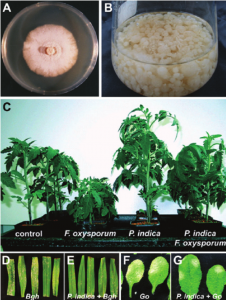How Microorganisms Help Tomato "Conquer" Saline Land Unveiled
The best way to eat fresh tomatoes is to add a little salt. But until now, salt or brackish water in the soil has been a taboo when growing these bright fruits.
Plant scientists in the Middle East have discovered that adding a desert rhizomatous fungus (
Pyricularia indica) to the soil can protect tomatoes from salt damage. Pyriformis was originally isolated in India.

Researchers grew tomatoes in greenhouses, like commercial growers, half in soil with fungi.
Over a four-month period, the researchers added half as much water to the soil with and without fungi, and the water had about one-third the salinity of seawater. The researchers found that tomato leaves extracted from plants infected with
P. indica contained an enzyme that removed harmful sodium from the cells. More importantly, the plant was better able to maintain appropriate levels of potassium, which is necessary for growth, a finding the team reported this month in
Horticultural Science.
In saline-irrigated plants, the yield of
P. indica-infected tomatoes was 65% higher than that of uninfected ones. Even infected tomatoes that were not irrigated with saline water had better harvests with a 22% increase in yield. Other studies have shown that this fungus can promote growth in barley and rice. In addition, another fungus has been shown to be beneficial under low salt conditions.
Plant scientists say that increasing these fungi is important because, by 2050, half of the world's arable soils will be "salty". The addition of fungi to soils may be a low-cost way to cope with such changes.
For research or industrial raw materials, not for personal medical use!
 Researchers grew tomatoes in greenhouses, like commercial growers, half in soil with fungi.
Over a four-month period, the researchers added half as much water to the soil with and without fungi, and the water had about one-third the salinity of seawater. The researchers found that tomato leaves extracted from plants infected with P. indica contained an enzyme that removed harmful sodium from the cells. More importantly, the plant was better able to maintain appropriate levels of potassium, which is necessary for growth, a finding the team reported this month in Horticultural Science.
In saline-irrigated plants, the yield of P. indica-infected tomatoes was 65% higher than that of uninfected ones. Even infected tomatoes that were not irrigated with saline water had better harvests with a 22% increase in yield. Other studies have shown that this fungus can promote growth in barley and rice. In addition, another fungus has been shown to be beneficial under low salt conditions.
Plant scientists say that increasing these fungi is important because, by 2050, half of the world's arable soils will be "salty". The addition of fungi to soils may be a low-cost way to cope with such changes.
Researchers grew tomatoes in greenhouses, like commercial growers, half in soil with fungi.
Over a four-month period, the researchers added half as much water to the soil with and without fungi, and the water had about one-third the salinity of seawater. The researchers found that tomato leaves extracted from plants infected with P. indica contained an enzyme that removed harmful sodium from the cells. More importantly, the plant was better able to maintain appropriate levels of potassium, which is necessary for growth, a finding the team reported this month in Horticultural Science.
In saline-irrigated plants, the yield of P. indica-infected tomatoes was 65% higher than that of uninfected ones. Even infected tomatoes that were not irrigated with saline water had better harvests with a 22% increase in yield. Other studies have shown that this fungus can promote growth in barley and rice. In addition, another fungus has been shown to be beneficial under low salt conditions.
Plant scientists say that increasing these fungi is important because, by 2050, half of the world's arable soils will be "salty". The addition of fungi to soils may be a low-cost way to cope with such changes.